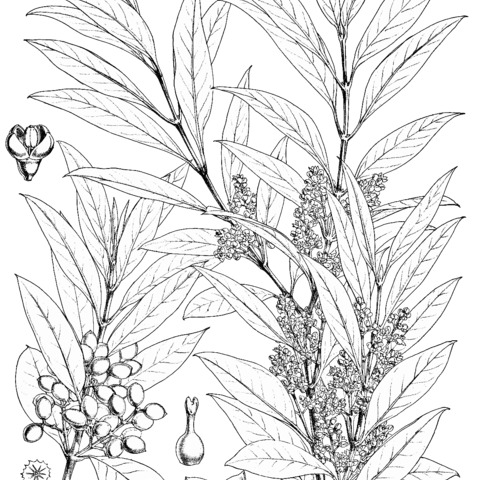Trees, often 3-14 m high, sometimes stunted bushy growths; branchlets verrucose. Leaves with a tendency for the sides to curl downwards as well as marginal rim being reflexed, dark green above, paler beneath where it is densely covered, rarely fairly sparsely so, with small silvery, golden or pale green scales, linear-lanceolate or narrowly oblong-elliptic, narrowed at base and apex (apex sometimes bluntly rounded), 1.9-8.5 cm long and 0.7-1.5 cm broad, rarely broader (see Clanwilliam and Barberton specimens), mucronate; midrib impressed above, prominent beneath; lateral veins obscure or faintly obvious, loops forming a more or less continuous line within the margin; petiole usually 3-10 mm long. Panicles axillary, sometimes a short terminal panicle present, varying in size, usually shorter than the subtending leaf, the branches verrucose and scaly; bracts deciduous. Flowers small, white. Calyx cupular, up to 1 mm long, very shortly and obscurely 4-toothed. Corolla with a short tube, about 1 mm long; lobes more or less connivent, eventually spreading to reflexed, about 2 mm long, 1.5 mm broad, margins narrowly infolded. Stamens inserted on the corolla, filaments under 1 mm long, more or less terete, anthers attached near the base, 1.5 mm long, 1 mm broad. Ovary subglobose, norrowing into a short style; stigma 2-lobed forming a conico-globose head; ovules pendulous. Drupe green with whitish spots turning black or prune-coloured, subglobose to oblong in outline, up to 1 cm by 9 mm on dry speciments.
More
A tree 10-15 m tall. It has a rounded crown and grey-green leaves. The trunk is crooked and it has characteristic pockets. The bark is rough and dark brown. The small branches are white and dotted with breathing pores. The leaves are narrow, oval and pointed. They are in opposite pairs. The underside of the leaves is pale white. The flowers are small and white in branched heads 5 cm across. The fruit is oval and fleshy and 1 cm long. It is purple when ripe. The seed is about 1 cm long.
Shrubs or small trees 3-10 m. Branchlets and leaf blade abaxially rusty lepidote. Leaf blade narrowly lanceolate to narrowly oblong-elliptic, 3-10 1-2 cm, apex acuminate, cuspidate. Panicles axillary, 1-4 1-2 cm. Flowers bisexual. Drupe broadly ellipsoid or subglobose, 7-9 4-6 mm, mesocarp somewhat fleshy, thin. Fl. Apr-Aug, fr. Aug-Nov.
A tropical plant. It occurs in dry forest in East and Southern Africa. It grows between 700 and 3,000 m altitude. It grows in areas with an annual rainfall between 100-1,200 mm. It can grow in alkaline soil. It can tolerate drought. It can grow in arid places. It suits plant hardiness zones 8-11. Melbourne Botanical gardens.

